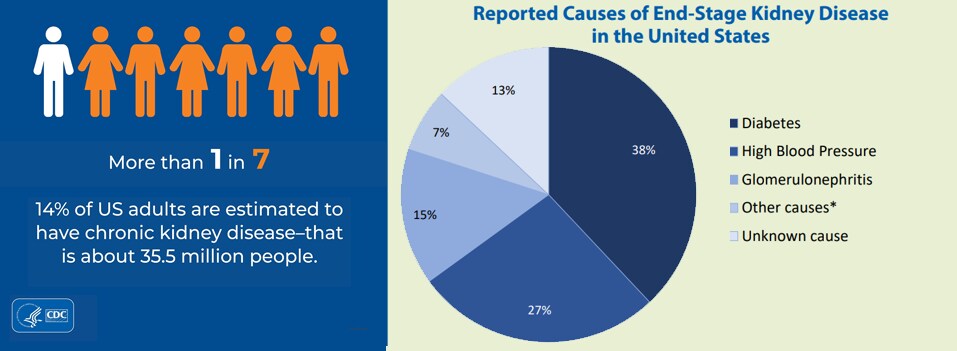What to know
- More than 1 in 7 U.S. adults has chronic kidney disease (CKD), though most do not know it.
- CKD is caused by damaged kidneys that cannot properly filter blood, causing fluids and waste to build up in the body.
- CKD usually gets worse over time, but treatment and lifestyle changes can slow it down.
- Public health strategies—from public and provider education, to monitoring CKD and its risk factors—can promote kidney health.
Definition details
Population
All residents.
Numerator
Number of new patients requiring dialysis or transplantation during a calendar year.
Denominator
Midyear resident population for the same calendar year.
Measure
Annual incidence number (crude and adjusted by age, sex, race, and ethnicity) [cases per 1,000,000].
Time Period of Case Definition
Calendar year.
Summary
The number of patients with newly registered end-stage kidney disease (ESKD), or kidney failure, increased from 94,466 in 2000 to 134,862 in 2019 (43% increase).1 However, there were 130,522 newly registered ESRD cases in 2020, representing about a 3.2% decrease from 2019.1 The age, sex, and race/ethnicity adjusted incidence of ESKD increases with age. In 2020, the incidence was 12 per million population (pmp) among individuals aged 0–17 years, while it was 1,447 pmp among individuals aged ≥75 years.1 Diabetes and hypertension are the leading causes of ESKD in the United States. Diabetes and chronic heart failure accounted for about 60% and 28%, respectively, of new cases of ESKD in 2020.1 Chronic kidney disease can be detected early through simple blood and urine tests. Taking medications, making lifestyle changes, and keeping blood sugar and blood pressure under control can help prevent chronic kidney disease and other diabetes complications.2
Notes
The ESKD population includes dialysis and kidney transplant recipients. The estimates are based on Census Bureau and Centers for Medicare and Medicaid Services (CMS) Medical Evidence Form (CMS 2728) data collections.3 The denominator is the general population and is not specific to the population at risk of developing ESKD. Since data are available only for patients whose ESKD therapies are reported to CMS, patients who die of ESKD before receiving treatment or whose therapies are not reported to CMS are not included in the United States Renal Data System (USRDS) database.
Data Source
United States Renal Data System (USRDS)
Related Objectives or Recommendations
Healthy People 2030 objective: CKD-07. Reduce the rate of new cases of end-stage kidney disease.
Related CDI Topic Area
None.
Reference 1
United States Renal Data System. 2022 USRDS Annual Data Report: Epidemiology of Kidney Disease in the United States. National Institutes of Health, National Institute of Diabetes and Digestive and Kidney Diseases; 2022. https://adr.usrds.org/2022
Reference 2
Chronic Kidney Disease Initiative. Chronic Kidney Disease Basics. Centers for Disease Control and Prevention. Accessed April 5, 2023. https://www.cdc.gov/kidneydisease/basics.html
Reference 3
Office of Disease Prevention and Health Promotion. Healthy People 2030: Objectives and Data. Centers for Disease Control and Prevention, U.S. Department of Health and Human Services. Accessed April 5, 2023. https://health.gov/healthypeople

